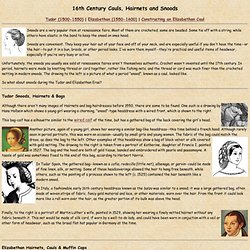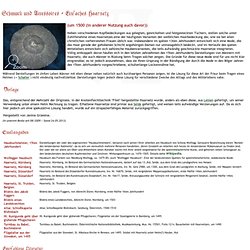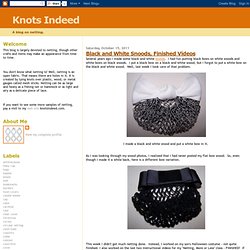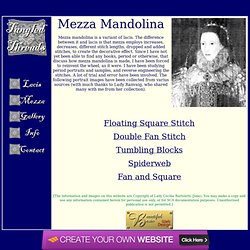

Cauls, Hairnets & Snoods. Tudor (1500-1550) | Elizabethan (1550-1600) | Constructing an Elizabethan Caul Snoods are a very popular item at renaissance fairs.

Most of them are crocheted; some are beaded. Some tie off with a string, while others have elastic in the band to keep the snood on ones head. Snoods are convenient. They keep your hair out of your face and off of your neck, and are especially useful if you don't have the time--or the hair--to put it in a bun, braids, or other period looks. Unfortunately, the snoods you usually see sold at renaissance faires aren't themselves authentic. So what about snoods during the Tudor and Elizabethan Eras? Tudor Snoods, Hairnets & Bags Although there aren't many images of Hairnets and bag hairdresses before 1550, there are some to be found. Diu Minnezît - Schmuck und Accessoires - Einfaches Haarnetz. (um 1500 (in anderer Nutzung auch davor)) Neben verschiedenen Kopfbedeckungen aus gelegten, gewickelten und festgesteckten Tüchern, stellen solche unter Zuhilfenahme eines Haarnetzes eine der häufigsten Varianten der weiblichen Haarbedeckung dar, wie sie bei allen christlichen verheirateten Frauen üblich war.

Insbesondere im späten 13ten Jahrhundert entwickelt sich eine Mode, die das Haar gerade der gehobenen Schicht angehörigen Damen nur unmassgeblich bedeckt, und im Verlaufe des späten Mittelalters entwickeln sich zahlreiche Haubenvarianten, die teils aufwändig geschmückte Haarnetze integrieren.Völlig entkoppelt davon häufen sich in den letzten Jahrzehnten des 15ten Jahrhunderts Darstellungen von Männern mit Haarnetz, die auch Männer in Rüstung beim Tragen solcher zeigen. Geschichte der Frisuren. Extant Medieval Hairnet photos on the Web « February 20, 2011 at 6:16 pm | Posted in Netting | 9 Comments I have been trying to track down as many extant hairnets from the middle ages as possible, to use in my research of medieval netting.

I thought that since I am hopefully not the only person interested in such things that posting a listing of as many of the hairnets as I could find might be helpful to others. Because I am unsure of exactly how the copyright laws work, most of these are just links to where you can actually find the pictures. 1. a hairnet made of silk (1300) that is apparently in the Germanisches National Museum in Nurmberg. The black and white picture shows even square mesh with lacis designs. Dreams of Lace: Other Lace Showcase. Books/Patterns | Links Netting is an old crafts technique basing on the nets that fishermen have always worked.

For decorative netting a different, but similiar Knot is used. When netting doilies in the round the pattern is worked at the same time as the ground. Patterns are done by working several knots into the same loop (shell stitch) or by gathering several loops with one single knot. Loops can be twisted or crossed when being worked into to get more patterns. Classical Netting, also called Filet Lace, embroidered net or Lacis is worked in two operations. Filet is very delicate, because the size of only one thread makes the basic element of the work, not several as in other lace techniques (crochet = 4 threads - loop inside of loops; tatting = 2 threads - knots over a central thread, bobbin lace = 2 threads - a twisted pair of threads).
The knot is made with a special tool, the netting needle: Knots Indeed. This week I finished the second net bag for the double baby shower.

It is also done as a spiral from the top, so it does look similar to the bag I finished last week. However, since I have a hard time repeating the same pattern over and over unless I have a good reason, there are some differences. First, the handles. They look different because of where the increases are placed. Beginning about half way down the handle, the pink bag, made last week, has increases placed along the edges of the handle. The blue bag has a straight handle.
Design Center. Mezza Mandolina. Mezza MandolinaRe-Creating a Lace Form Lady Cecilia Bartoletti First Things First -- Lacis The foremost experts on lace -- Ricci and Levey -- agree that mezza mandolina is a variant of lacis, but do not give much more detail than that.

But what the heck is lacis? It is arguably the oldest lacemaking form; pieces have been found dating to the earliest years of the 14th century. However, one of her own stitches was an exact duplicate of the photograph Lady Ranvaig had given me. I had a place to start. The Patterns NOTE: I have found no period manuals that name the patterns shown in these paintings. In knitting, there is only "knit" and "purl," combined in specific sequences to create the thousands of possible patterns. Figure 16 Figure 18. Tangled Threads - Mezza Mandolina. Mezza Mandolina Mezza mandolina is a variant of lacis.

The difference between it and lacis is that mezza employs increases, decreases, different stitch lengths, dropped and added stitches, to create the decorative effect. Since I have not yet been able to find any books, period or otherwise, that discuss how mezza mandolina is made, I have been forced to reinvent the wheel, as it were. I have been studying period portraits and samples, and reverse engineering the stitches. A lot of trial and error have been involved. Floating Square Stitch Double Fan Stitch Tumbling Blocks Spiderweb Fan and Square.
HOME - Filet in Tondo di Enza Termine.